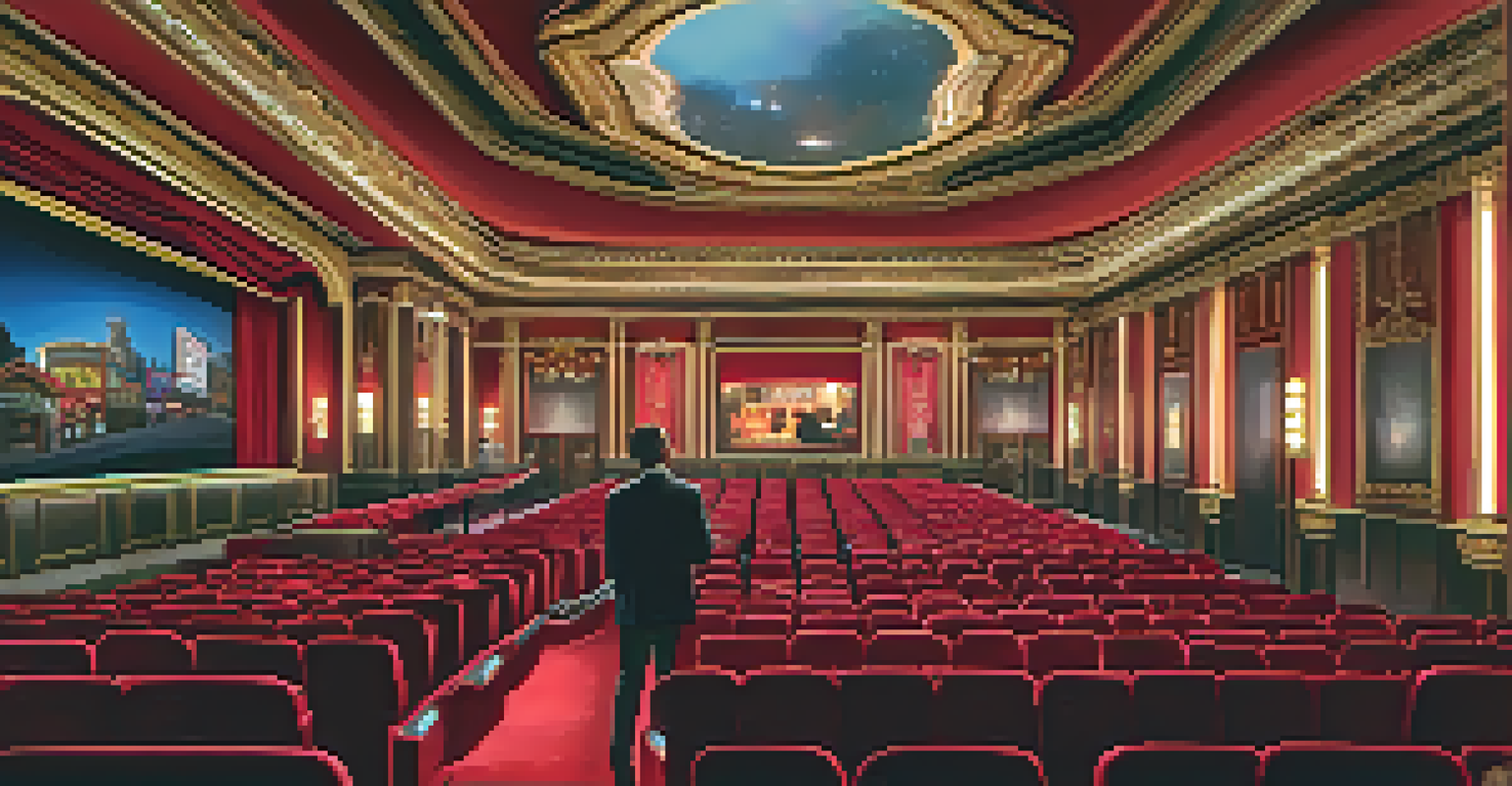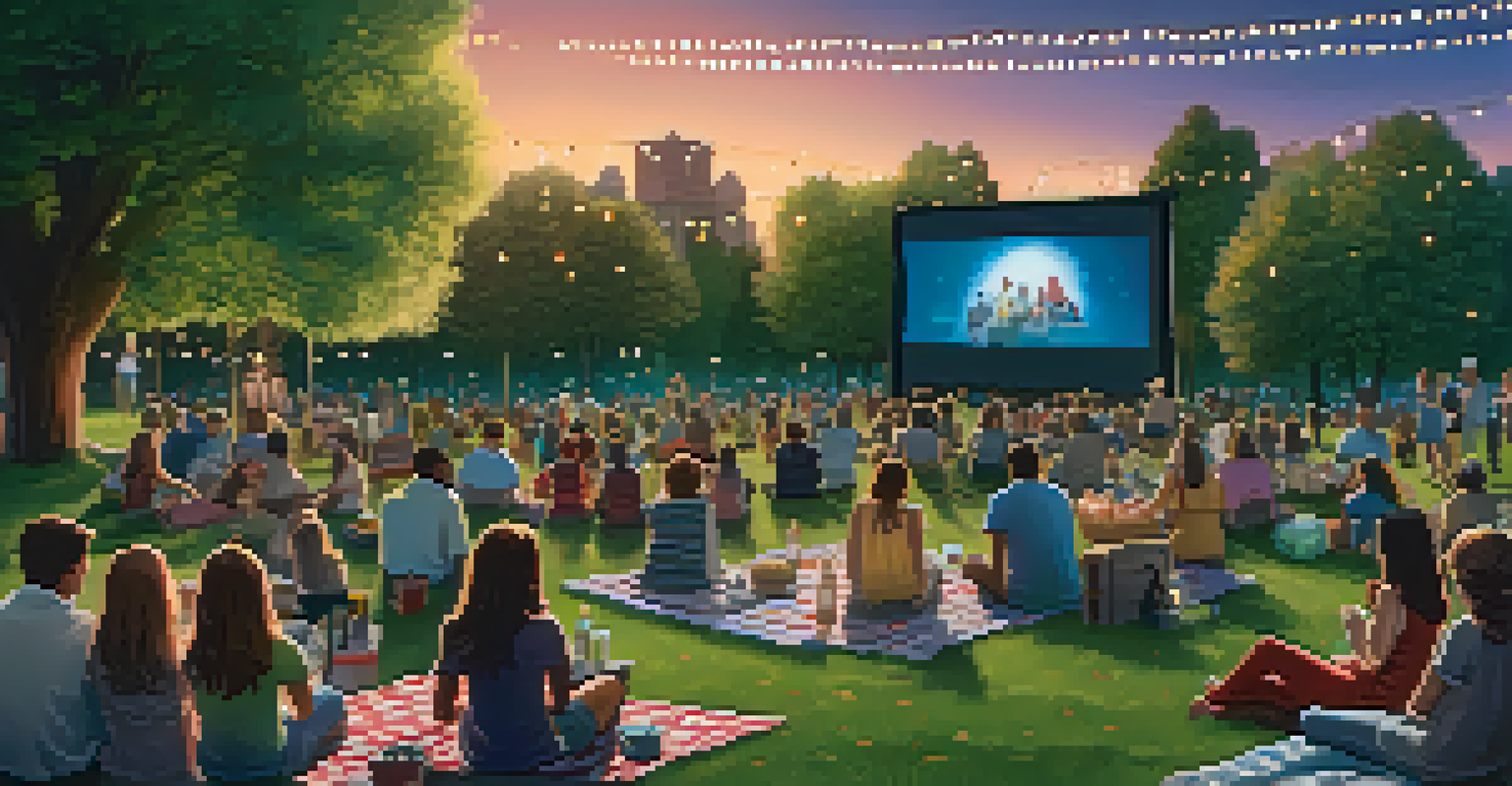The Rise of Streaming Services and Their Impact on Theaters

The Evolution of Streaming Services in Entertainment
Over the past decade, streaming services have transformed how we consume entertainment. Platforms like Netflix, Hulu, and Amazon Prime Video have made it easier than ever to access a vast library of films and shows from the comfort of our homes. This shift has not only changed viewing habits but also influenced the production and distribution of content, leading to a new era of entertainment consumption.
Streaming services have transformed how we consume entertainment, making it easier than ever to access a vast library of films and shows from the comfort of our homes.
As streaming subscriptions have skyrocketed, traditional media outlets have had to adapt or risk falling behind. The convenience of on-demand viewing means that audiences are less inclined to visit theaters for a movie they can watch at home. This evolution has prompted theaters to rethink their business models, leading to innovations in the cinema experience to lure viewers back.
Ultimately, the rise of streaming services has democratized content access, enabling more diverse stories to reach audiences. With the click of a button, viewers can discover indie films or international cinema that might never make it to their local theater, broadening the cinematic landscape and changing the way we perceive entertainment.
The Impact of Streaming on Movie Theaters
The surge in streaming services has undeniably affected the box office revenue of theaters worldwide. Many consumers now prefer to wait for movies to be released on streaming platforms instead of purchasing tickets. This change in consumer behavior has led to a decline in attendance, forcing theaters to rethink their strategies to maintain relevance in a rapidly evolving market.

Moreover, the pandemic accelerated this trend, as lockdowns prompted many studios to prioritize streaming releases over traditional theatrical ones. Films that might have been blockbuster hits in theaters found success on platforms like Disney+ and HBO Max, further diminishing the exclusivity that theaters once enjoyed. This shift raises questions about the future of theatrical releases and the economics of movie-making.
Streaming Services Reshape Viewing Habits
The rise of streaming platforms like Netflix has transformed how audiences consume entertainment, leading to a shift from traditional theaters to on-demand viewing.
In response, theaters are experimenting with new models, such as offering premium experiences or hosting exclusive events, to entice audiences. By creating a unique atmosphere that streaming cannot replicate, theaters hope to remind viewers of the magic of the big screen experience, even amidst the convenience of home viewing.
Changing Audience Expectations and Preferences
As streaming services continue to shape the entertainment landscape, audience expectations are evolving too. Viewers today seek flexibility and variety, wanting to choose when and how they consume content. This shift has led to a more casual relationship with film-going, where the excitement of a theater visit may not feel as essential as it once did.
By embracing change and adapting to audience preferences, theaters can find new ways to engage viewers and remain relevant.
Furthermore, streaming platforms have made it easier for audiences to explore niche genres and discover new filmmakers. This increased exposure fosters a deeper appreciation for diverse storytelling, which can sometimes be overshadowed in mainstream theaters. As a result, audiences are becoming more discerning about the content they consume, influencing what gets produced and promoted.
The growing demand for diverse and inclusive content reflects a broader cultural shift, pushing theaters to adapt their offerings. To stay connected with their audiences, they must not only showcase blockbuster hits but also feature independent and international films that resonate with today's viewers.
The Role of Original Content in Streaming Success
Original content has become a key differentiator for streaming platforms, driving subscriptions and viewer engagement. By investing in exclusive films and series, services like Netflix and Apple TV+ have not only attracted audiences but also created buzz around their offerings. This strategy has prompted traditional studios to rethink their approach to content creation and distribution.
The success of original films, such as 'Roma' or 'The Irishman,' has shown that streaming services can produce award-winning content that rivals traditional cinema. This blurring of the lines between streaming and theatrical releases has sparked conversations about the future of film festivals and award shows, with streaming now playing a significant role in the cultural narrative.
Theater Strategies for Relevance
In response to the impact of streaming, theaters are innovating by enhancing experiences and hosting exclusive events to attract audiences back.
As audiences become accustomed to high-quality programming available at their fingertips, the pressure is on theaters to keep pace. The challenge lies in balancing the allure of exclusive streaming content with the unique experience that movie theaters offer, ensuring that both mediums can coexist and thrive.
Innovative Strategies for Theaters to Compete
In response to the challenges posed by streaming services, theaters are adopting innovative strategies to attract audiences. Some are enhancing the viewing experience by upgrading technology, such as offering IMAX screens or state-of-the-art sound systems, making the theater visit feel special. Others are focusing on creating a community atmosphere by hosting special screenings, Q&A sessions with filmmakers, or themed events.
Additionally, some theaters are embracing the idea of hybrid models, allowing for a combination of theatrical and streaming releases. By offering exclusive screenings of films that will later be available on streaming platforms, they can create buzz and draw in crowds eager to see the latest hits before they are accessible at home.
Ultimately, the goal is to create an experience that cannot be replicated at home, fostering a sense of nostalgia and excitement around the cinematic experience. By embracing change and thinking outside the box, theaters can carve out a niche in a competitive landscape.
The Future of Film and Distribution Models
As we look to the future, the film industry will likely continue to evolve in response to the rise of streaming services. The traditional distribution model, where films are released exclusively in theaters for a set period before hitting home video, is already shifting. We may see more simultaneous releases or shorter theatrical windows as studios adapt to consumer demand.
This change could lead to a more fluid relationship between theaters and streaming services, where both can coexist and support one another. Collaborations between studios and streaming platforms may become the norm, offering audiences more choices and flexibility in how they experience films.
Future of Film Distribution Models
The film industry is evolving towards more flexible distribution methods, including simultaneous releases, to accommodate changing consumer preferences.
Ultimately, the future of film will require a balance between traditional and modern distribution methods. By embracing innovation and audience preferences, both theaters and streaming services can thrive in a rapidly changing landscape.
Conclusion: Embracing Change in the Entertainment Industry
The rise of streaming services has undoubtedly changed the landscape of the entertainment industry, presenting both challenges and opportunities for theaters. While some may view streaming as a threat, it can also be seen as a catalyst for innovation within the industry. By embracing change and adapting to audience preferences, theaters can find new ways to engage viewers and remain relevant.
As consumers continue to seek diverse content and flexible viewing options, theaters will need to rethink their approaches to attract audiences. This may involve reimagining the cinematic experience, offering unique events, or collaborating with streaming platforms to create a more integrated model.

Ultimately, the future of film and theaters lies in the ability to adapt and evolve together. By meeting the needs of today's viewers, the industry can forge a path that honors the magic of cinema while embracing the convenience of streaming.